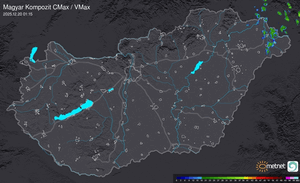Modell-iskola
Ha valakit esetleg érdekel, a december 9.-i NCEP model review konferencián bemutatott prezentációkat itt lehet megtalálni: Link
A GFS-rõl fõleg a Global Weather Modeling elõadásban lehet olvasni.
Érdekes, hogy kigyûjtötték a modell jellemzõ gyenge pontjait:
-Large growth in rms error in first 24 hours in midlatitudes
-Large growth in rms error in first 48 hours in tropics
-Too much surface downward short wave radiation
-Warm low-level bias over western US in summer
-Negative height bias over Antarctica
-Poor scores in Southern Hemisphere
-Lack of stratus clouds in fcsts; displacement of stratus clouds from coasts
-Higher precipitation than independent estimates
-Cold bias over US in winter
-Negative moisture
-Relatively low QPF scores
-Failure to maintain rising motion over Indonesia in the forecasts
-Failure to capture early stages (TD) of tropical systems
-High bias for areal coverage of low QPF amounts (< 0.10 in.)
-Grid scale overturning induces spurious mid-level vorticity maxima, particularly in the warm season.
-Too cold with the melting layer in wintry precipitation events
-Too flat with strongly amplifying troughs/closed lows in the western U.S. resulting in the model being too fast to eject these systems out to the east
-Too far east with the track of East Coast/Gulf Stream cyclones
-Lack of terrain resolution adversely impacts QPF in the western U.S. and in other areas of complex terrain, such as southern Mexico.
-GFS forecasts conditions favorable for heavy lake effect snow but has low amounts of QPF
Routinely places a trough over the eastern Brooks Range in Alaska
Too weak and fast with well-developed Pacific systems more than a couple of days into the forecast period
-Too aggressive bringing energy into the western side of ridges
-Cold bias in the longer ranges over the eastern U.S./western Atlantic
-Surface lows coming out of the west into the Plains are too far north The model tends to focus too much QPF in the cold sector of cyclones
Sok megállapítás inkább csak az USA-ra vonatkozik, de talán itt is tapasztalható azokból is valami.
Egyébként a sztrátuszfelhõzet hiánya szembetûnõ, viszont a Negative moisture nem tudom mit takarhat pontosan, én inkább az ellenkezõjérõl hallottam a GFS-el kapcsolatban.
Ha valamit meg tudtok erõsíteni/cáfolni, vagy egy újabb jellemzõ hibájáról tudtok, akkor bõvítsük a listát, hasznos lehet.
A GFS-rõl fõleg a Global Weather Modeling elõadásban lehet olvasni.
Érdekes, hogy kigyûjtötték a modell jellemzõ gyenge pontjait:
-Large growth in rms error in first 24 hours in midlatitudes
-Large growth in rms error in first 48 hours in tropics
-Too much surface downward short wave radiation
-Warm low-level bias over western US in summer
-Negative height bias over Antarctica
-Poor scores in Southern Hemisphere
-Lack of stratus clouds in fcsts; displacement of stratus clouds from coasts
-Higher precipitation than independent estimates
-Cold bias over US in winter
-Negative moisture
-Relatively low QPF scores
-Failure to maintain rising motion over Indonesia in the forecasts
-Failure to capture early stages (TD) of tropical systems
-High bias for areal coverage of low QPF amounts (< 0.10 in.)
-Grid scale overturning induces spurious mid-level vorticity maxima, particularly in the warm season.
-Too cold with the melting layer in wintry precipitation events
-Too flat with strongly amplifying troughs/closed lows in the western U.S. resulting in the model being too fast to eject these systems out to the east
-Too far east with the track of East Coast/Gulf Stream cyclones
-Lack of terrain resolution adversely impacts QPF in the western U.S. and in other areas of complex terrain, such as southern Mexico.
-GFS forecasts conditions favorable for heavy lake effect snow but has low amounts of QPF
Routinely places a trough over the eastern Brooks Range in Alaska
Too weak and fast with well-developed Pacific systems more than a couple of days into the forecast period
-Too aggressive bringing energy into the western side of ridges
-Cold bias in the longer ranges over the eastern U.S./western Atlantic
-Surface lows coming out of the west into the Plains are too far north The model tends to focus too much QPF in the cold sector of cyclones
Sok megállapítás inkább csak az USA-ra vonatkozik, de talán itt is tapasztalható azokból is valami.
Egyébként a sztrátuszfelhõzet hiánya szembetûnõ, viszont a Negative moisture nem tudom mit takarhat pontosan, én inkább az ellenkezõjérõl hallottam a GFS-el kapcsolatban.
Ha valamit meg tudtok erõsíteni/cáfolni, vagy egy újabb jellemzõ hibájáról tudtok, akkor bõvítsük a listát, hasznos lehet.


